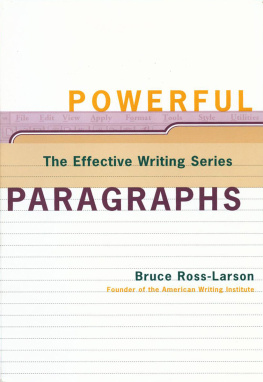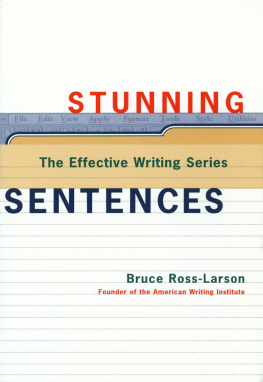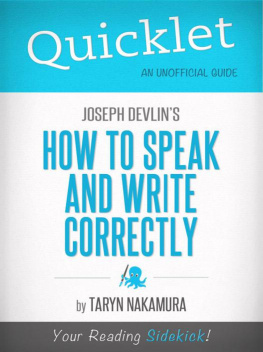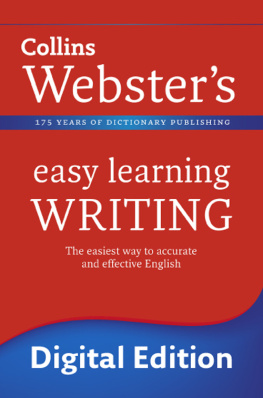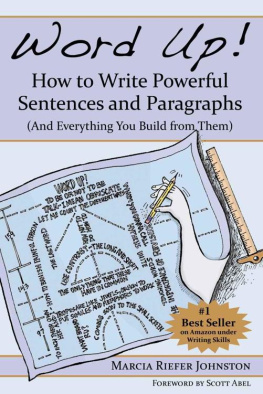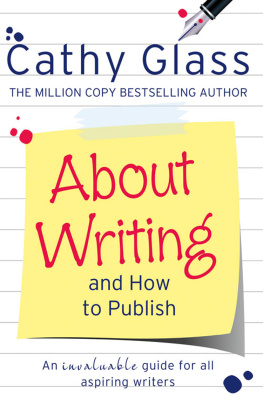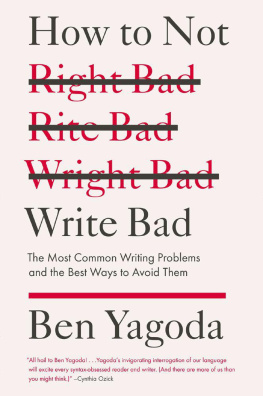POWERFUL PARAGRAPHS
THE EFFECTIVE WRITING SERIES
BRUCE ROSS-LARSON

W. W. NORTON & COMPANY NEW YORK LONDON
Copyright 1999 by Bruce Ross-Larson
All rights reserved
Library of Congress Cataloging-in-Publication Data
Ross-Larson, Bruce Clifford, 1942
Powerful paragraphs / Bruce Ross-Larson.
p. cm.(The effective writing series)
ISBN: 978-0-393-31794-7
1. English languageParagraphsProblems, exercises, etc. 2. English languageRhetoricProblems, exercises, etc. 3. Report writingProblems, exercises, etc. I. Title. II. Series: Ross-Larson, Bruce Clifford, 1942-Effective writing series.
PE1439.R67 1999
808'.042dc21
98-35265
CIP
W. W. Norton & Company, Inc., 500 Fifth Avenue, New York, N.Y. 10110
www.wwnorton.com
W. W. Norton & Company Ltd., Castle House, 75/76 Wells Street, London WIT 3QT
For Veruschka
and all my colleagues at the
American Writing Institute
CONTENTS
AUTHORS NOTE
THE techniques presented here, refined in the workshops Ive conducted over the past fifteen years, are intended to help you write paragraphs that are unified, coherent, and well developed. The questions about identifying a paragraphs topic and pointand about determining whether each of a paragraphs sentences bears on that pointshould help you spot problems and quickly solve them. The patterns of paragraph development should allow you to inject your writing with variety and interest. And the suggested transitions between paragraphs should enable you to extend the coherence of your argument, making it easier for your readers to follow. If you run across exemplars of the paragraph models identified hereor find interesting variants, indeed new speciesplease send them to me at bruce@cdinet.com or browse into (www.cdinet.com/AmericanWritingInstitute). Ill try to plug them into the next edition.
Id like to acknowledge the contributions of my colleagues at the American Writing Institute: Amy Cracknell, Andrea Brunholzl, Jessica Moore, Erika Schelble, Alison Smith, Kelli Ashley, and the interns Brendan McCarthy, Adam Calderon, Jessica Henig, and Ana Dahlman. Id also like to acknowledge those of my editorial colleagues at Communications Development who reviewed the manuscript throughout its many stages: Meta de Coquereaumont, Alison Strong, Paul Holtz, Daphne Levitas, and Heidi Gifford. And Id like to thank Xan Smiley and The Economist for the permission to reproduce the piece attached at the back and the many writers credited with the individual paragraphs Ive used as examples.
B RUCE R OSS -L ARSON
Washington, D.C.
POWERFUL PARAGRAPHS
AN APPROACH TO PARAGRAPHS
MANY writers think of paragraphs as a collection of sentences framed by an indent and a carriage return, running perhaps ten or twelve lines. Few have the language to describe whats goodor badabout a paragraph. This book shows you what it means for a paragraph to be unified, coherent, and well developed. The idea here is to give you a way of looking at paragraphs that will change the way you write.
A paragraph is unified if each sentence is clearly related to the point, coherent if you make it obvious to your reader how each sentence is linked to the point. You can make the link more obvious by repeating key words and phrases. You can also use transitional words and phrases to enumerate and coordinate a paragraphs sentences. And you can change the structure of your sentences to reveal parallel or subordinate ideas. These techniques do more than make your paragraphs coherentthey also give them pace.
A paragraph is well developed if its sentences unfold in a way that makes your argument perfectly clear to the reader. One of the best ways to do this is to express the point of the paragraph as a general statement in the first sentence and then to support it with details and examples in subsequent sentences. Used for perhaps half to two-thirds of all paragraphs in expository writing, this model is among the most common. Some of the other ways are to conclude with the point, to phrase the point as a question and answer, and to undermine an argument to make the opposite point. Still other ways include making a subtle (or not so subtle) comment at the end of a straightforward series of details. Deciding how you develop a paragraph generally depends on the details, examples, and comments you have to support your point.
BUILDING PARAGRAPHS FROM A PLAN
Strong paragraphs will emerge more easily if you have done some planning. ( Riveting Reports , also in this series, is a good place to start.) A paragraph-by-paragraph plan helps you organize your material by going beyond an outline to identify the topic of each paragraph in an entire piece. You then write the topic of each paragraph at the top of a sheet of paper (or page screen, if youre online) and try to make a strong point about each topic. Finally you assemble your raw materialdetails, comments, examplesunder those points. With your material thus organized, and your head significantly clearer, youre ready to write unified, coherent, well-developed paragraphs.
GETTING OFF TO A GOOD START
Opening paragraphs have tremendous effect on howand whetheryour piece will be read. The most common opening is the throat-clearing paragraph that blandly announces how the piece will unfold. What you want instead is to grab your readers attention, rivet them to your message, and propel them through your argument. Here are a few ways to do just that.
Put your main message up front . Tell your readers exactly what you intend to get across to them by setting out your main and any supporting messages up front, where they cant be missed.
In no society today do women enjoy the same opportunities as men. This unequal status leaves considerable disparities between how much women contribute to human development and how little they share in its benefits.
Start with a gripping fact . Present a compelling (or even shocking) fact or statistic that you suspect your readers will find interesting.
Every twenty minutes or so, someone somewhere is killed or injured by a landmine. According to the United Nations more than 110m buried mines are left over from the 20th centurys numerous warsmost of them in poor countries such as Afghanistan, Angola and Cambodia which can ill afford the cost of removing them.
Ask questions . Ask questions to draw your readers in as participants, enticing them to read on and find out the answers.
Swamped by voicemail and email? Prepare yourself for the next wave of digital communications deluge: instant messaging.
Set the scene . Descriptive details can pull readers in by helping them to visualize the scene youre setting.
Out here in Big Sky Country, high on a ridge in the Absaroka Range, a golden eagle soars, pushed upward by a stream of warm air. From its perch in a golden-leafed aspen, a Stellers jay the color of indigo shrieks at the interlopers 20 feet below. A Clarks nutcracker drills into a pine cone, the only sound except the distant rumble from the Yellowstone River.
Surprise your readers . Humor can put your readers at ease, a tactic especially useful before launching into a controversial topic.
The bagpipes appeal is difficult to explain. Playing it can be a lonely calling. At a party, nobody asks you to sit down and bang out a song. You wear a skirt. There are the jokes.
Present a brief history . Starting with a historical anecdote adds the interest of analogyand boosts your credibility.

